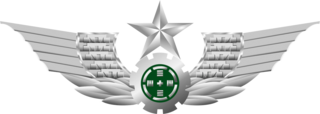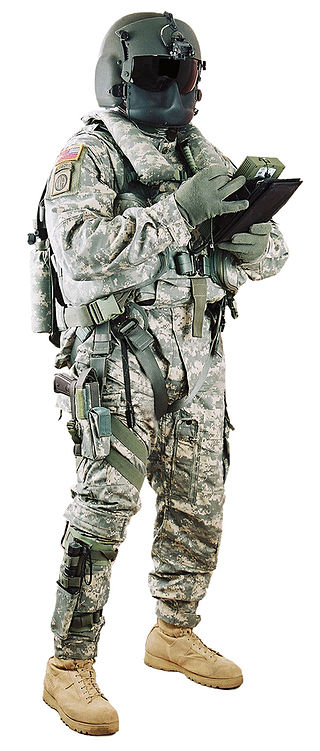Related Research Articles

Infantry is a specialization of military personnel who engage in warfare combat. Infantry generally consists of light infantry, irregular infantry, heavy infantry, mountain infantry, motorized infantry, mechanized infantry, airborne infantry, air assault infantry, and naval infantry. Other types of infantry, such as line infantry and mounted infantry, were once commonplace but fell out of favor in the 1800s with the invention of more accurate and powerful weapons.

The SA80 is a British family of 5.56×45mm NATO service weapons used by the British Army. The L85 Rifle variant has been the standard issue service rifle of the British Armed Forces since 1987, replacing the L1A1 Self-Loading Rifle. The prototypes were created in 1976, with production of the A1 variant starting in 1985 and ending in 1994. The A2 variant came to be as the result of a significant upgrade in the early 2000s by Heckler & Koch and remains in service as of 2023. The A3 variant was first issued in 2018 with several new improvements.

The Steyr AUG is an Austrian bullpup assault rifle chambered for the 5.56×45mm NATO intermediate cartridge, designed in the 1960s by Steyr-Daimler-Puch, and now manufactured by Steyr Arms GmbH & Co KG.

Land Warrior was a United States Army program, launched in 1989, officially got its name in 1994, cancelled in 2007 but restarted in 2008, that used a combination of commercial, off-the-shelf technology (COTS) and current-issue military gear and equipment designed to:

The Warrior tracked vehicle family is a series of British armoured vehicles, originally developed to replace FV430 series armoured vehicles. The Warrior started life as the MCV-80, "Mechanised Combat Vehicle for the 1980s". One of the requirements of the new vehicle was a top speed able to keep up with the projected new MBT, the MBT-80 – later cancelled and replaced by what became the Challenger 1 – which the FV432 armoured personnel carrier could not. The project was begun in 1972; GKN Defence won the production contract in 1984 and the Warrior was accepted for service with the British Army in November 1984. Production commenced in January 1986 at Telford, with the first vehicles completed in December that year. GKN Defence was purchased by BAE Systems, via Alvis plc.

The People's Liberation Army Ground Force is the land-based service branch of the People's Liberation Army and also it's largest and oldest branch. The PLAGF can trace its lineage from 1927 as the Chinese Red Army; however, it was not officially established until 1948.

Future Soldier was a multi-nation military project launched by the United States and its allies in the late 1990s.

Infanterist der Zukunft is the German Bundeswehr's program as part of the Future Soldier project. It is a modular, integrated fighting system designed to provide significant lethality, survivability, mobility, battle command, and training to the German infantryman. It is being developed by EADS Defence Electronics and Rheinmetall-Detec.

FÉLIN is the name for the French infantry combat system developed by Safran Electronics & Defense.
Bowman is the name of the tactical communications system used by the British Armed Forces.
The Rapid Equipping Force (REF) was a United States Army organization headquartered in Fort Belvoir, Virginia. The organization was charged with quickly providing Army units deployed globally with innovative government off-the-shelf and commercially available solutions that address urgent requirements within 180 days or less. The REF was able to do this through unique authorities and by maintaining a presence near the point of need. REF personnel were positioned in Iraq, Afghanistan, and Kuwait and mobile laboratories are available for quick solutions. Additionally, the REF empowered the Army at a grassroots level, enabling individual soldiers to communicate needs directly through simple request forms.
The Lightweight Small Arms Technologies (LSAT) program is funded by the U.S. Joint Service Small Arms Program, with the goal of significantly reducing the weight of small arms and their ammunition. Following a series of military programs to investigate advances in small arms, the LSAT program is the US military's latest project to replace existing US small arms. Tactical concepts and the research from the previous small arms programs indicates that lightening small arms is the first significant step towards increasing soldiers' lethality and survivability.
F-INSAS is India's programme to equip its infantry with state-of-the-art equipment, F-INSAS standing for Future Infantry Soldier As a System. However the Indian Army has decided to drop the F-INSAS program in favour of two separate projects. The new program will have two components: one to arm the future infantry soldier with the best available assault rifle, carbines and personal equipment, such as helmets and bulletproof vests. The second component is the Battlefield Management Systems (BMS).
The Advanced Combat Man System (ACMS) is part of the Singapore Armed Forces's (SAF) move to integrate into 3G to progressively provide tactical units with network capabilities, including C4I capabilities in the field. The project costs about SG$100 million to maintain.

The M2 Bradley, or Bradley IFV, is an American infantry fighting vehicle that is a member of the Bradley Fighting Vehicle family. It is manufactured by BAE Systems Land & Armaments.
Program Executive Office Soldier is a US Army organization that is responsible for rapid prototyping, procurement, and fielding of equipment for the soldiers.

Ratnik is a Russian future infantry combat system. Some components, including the communication systems and night vision technologies, have extremely limited military distribution. It is designed to improve the connectivity and combat effectiveness of combat personnel in the Russian Armed Forces. Improvements include modernised body armour, a helmet with a special eye monitor, communication systems, and special headphones. It includes 10 subsystems and 59 individual items.

The Véhicule Blindé Multi-Rôle Griffon or VBMR Griffon is a French six-wheel multi-purpose armoured personnel carrier developed and manufactured by Nexter, Arquus and Thales. The vehicle entered service in 2019 and is, alongside the four-wheel VBMR-L Serval co-developed by Nexter and Texelis, the successor of the Véhicule de l'Avant Blindé (VAB).
Morpheus is the name of the programme that will deliver the next generation tactical communications system to the British Armed Forces.
References
- ↑ "On target – latest sights see infantry take on extra firepower" (PDF). May 2011. Retrieved 28 June 2017.
- 1 2 "Morpheus Project: next generation tactical communication information systems for defence". 1 August 2016. Retrieved 21 June 2017.
- ↑ "MOD Information Systems and Services & TechUK Industry Engagement Day". TechUK. 30 January 2017. Retrieved 28 June 2017.